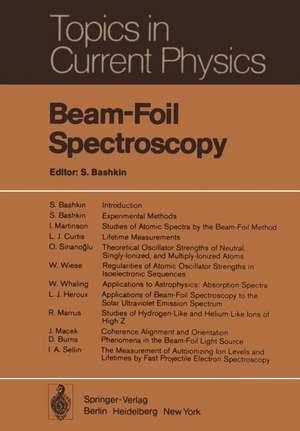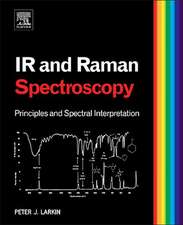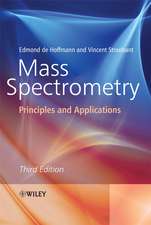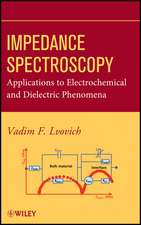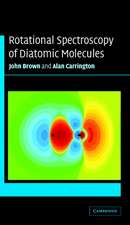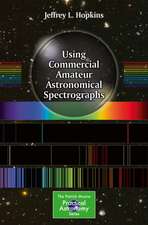Beam-Foil Spectroscopy: Topics in Current Physics, cartea 1
Editat de S. Bashkin Contribuţii de D. Burns, L.J. Curtis, L.J. Heroux, J. Macek, R. Marrus, I. Martinson, I. A. Sellin, O. Sinanoglu, W. Whaling, W. Wieseen Limba Engleză Paperback – 13 dec 2011
Din seria Topics in Current Physics
-
 Preț: 401.61 lei
Preț: 401.61 lei - 15%
 Preț: 644.63 lei
Preț: 644.63 lei -
 Preț: 389.31 lei
Preț: 389.31 lei -
 Preț: 391.99 lei
Preț: 391.99 lei - 15%
 Preț: 642.18 lei
Preț: 642.18 lei -
 Preț: 388.90 lei
Preț: 388.90 lei -
 Preț: 382.95 lei
Preț: 382.95 lei -
 Preț: 398.53 lei
Preț: 398.53 lei -
 Preț: 402.98 lei
Preț: 402.98 lei -
 Preț: 387.96 lei
Preț: 387.96 lei -
 Preț: 388.72 lei
Preț: 388.72 lei -
 Preț: 393.13 lei
Preț: 393.13 lei -
 Preț: 397.38 lei
Preț: 397.38 lei - 15%
 Preț: 642.83 lei
Preț: 642.83 lei -
 Preț: 384.86 lei
Preț: 384.86 lei -
 Preț: 383.33 lei
Preț: 383.33 lei -
 Preț: 385.25 lei
Preț: 385.25 lei -
 Preț: 382.36 lei
Preț: 382.36 lei -
 Preț: 382.36 lei
Preț: 382.36 lei -
 Preț: 382.18 lei
Preț: 382.18 lei -
 Preț: 384.86 lei
Preț: 384.86 lei -
 Preț: 397.59 lei
Preț: 397.59 lei - 15%
 Preț: 639.08 lei
Preț: 639.08 lei -
 Preț: 396.62 lei
Preț: 396.62 lei -
 Preț: 391.40 lei
Preț: 391.40 lei -
 Preț: 382.75 lei
Preț: 382.75 lei -
 Preț: 392.75 lei
Preț: 392.75 lei -
 Preț: 392.60 lei
Preț: 392.60 lei - 15%
 Preț: 643.16 lei
Preț: 643.16 lei -
 Preț: 392.97 lei
Preț: 392.97 lei -
 Preț: 407.01 lei
Preț: 407.01 lei - 15%
 Preț: 638.43 lei
Preț: 638.43 lei -
 Preț: 394.87 lei
Preț: 394.87 lei -
 Preț: 395.09 lei
Preț: 395.09 lei - 15%
 Preț: 641.38 lei
Preț: 641.38 lei -
 Preț: 402.38 lei
Preț: 402.38 lei -
 Preț: 390.63 lei
Preț: 390.63 lei -
 Preț: 387.38 lei
Preț: 387.38 lei -
 Preț: 398.35 lei
Preț: 398.35 lei -
 Preț: 393.35 lei
Preț: 393.35 lei -
 Preț: 384.09 lei
Preț: 384.09 lei - 15%
 Preț: 641.03 lei
Preț: 641.03 lei -
 Preț: 397.01 lei
Preț: 397.01 lei -
 Preț: 395.47 lei
Preț: 395.47 lei - 15%
 Preț: 646.94 lei
Preț: 646.94 lei -
 Preț: 399.67 lei
Preț: 399.67 lei - 15%
 Preț: 642.83 lei
Preț: 642.83 lei - 15%
 Preț: 638.24 lei
Preț: 638.24 lei
Preț: 393.13 lei
Nou
Puncte Express: 590
Preț estimativ în valută:
75.24€ • 78.25$ • 62.96£
75.24€ • 78.25$ • 62.96£
Carte tipărită la comandă
Livrare economică 14-28 martie
Preluare comenzi: 021 569.72.76
Specificații
ISBN-13: 9783642810541
ISBN-10: 3642810543
Pagini: 336
Ilustrații: XIII, 318 p.
Dimensiuni: 170 x 244 x 18 mm
Greutate: 0.54 kg
Ediția:1976
Editura: Springer Berlin, Heidelberg
Colecția Springer
Seria Topics in Current Physics
Locul publicării:Berlin, Heidelberg, Germany
ISBN-10: 3642810543
Pagini: 336
Ilustrații: XIII, 318 p.
Dimensiuni: 170 x 244 x 18 mm
Greutate: 0.54 kg
Ediția:1976
Editura: Springer Berlin, Heidelberg
Colecția Springer
Seria Topics in Current Physics
Locul publicării:Berlin, Heidelberg, Germany
Public țintă
ResearchCuprins
1. Experimental Methods.- 1.1 Accelerators.- 1.2 Ion Sources.- 1.3 Beam Requirements and Limitations.- 1.4 Mass Analyzers.- 1.5 Target Chambers.- 1.6 Targets.- 1.7 Analytical Devices.- 1.8 Detectors.- 1.9 Detection Geometry and Line Width.- 1.10 Beam Monitors.- 1.11 External Fields.- 1.12 Concluding Remarks.- References.- 2. Studies of Atomic Spectra by the Beam-Foil Method.- 2.1 Experimental Methods.- 2.2 Results of Spectral Studies.- References.- 3. Lifetime Measurements.- 3.1 Lifetime Studies as a Basic Area of Atomic Physics.- 3.2 Definitions of Basic Quantities.- 3.3 Measurement of Beam-Foil-Excited Decay Curves.- 3.4 Time Dependence of the Measured Decay Curves.- 3.5 Mean-Life Extraction by Exponential Fits to Individual Decay Curves.- 3.6 Mean-Life Extraction by Joint Analysis of Cascade-Related Decay Curves.- 3.7 Cascade-Free Methods.- 3.8 Concluding Remarks.- References.- 4. Theoretical Oscillator Strengths of Neutral, Singly-Ionized, and Multiply-Ionized Atoms: The Theory, Comparisons with Experiment, and Critically-Evaluated Tables with New Results.- 4.1 The Non-Closed-Shell Many-Electron Theory.- 4.2 A Spectroscopic Interpretation of the Charge Wave Function.- 4.3 NCMET Calculations,.- 4.4 States Not Lowest of Their Symmetry.- 4.5 New Oscillator Strengths for Intershell (KL ? KL’[M]) Transitions to Pre-Rydberg Levels (V ? pR).- 4.6 Further Examination of Remaining Correlation Effects on Oscillator Strengths with NCMET.- 4.7 Conclusion.- References.- 5. Regularities of Atomic Oscillator Strengths in Isoelectronic Sequences.- 5.1 Theoretical Basis.- 5.2 Discussion of Established Trends.- 5.3 Oscillator-Strength Distributions in a Spectral Series Along an Isoelectronic Sequence.- 5.4 Relativistic Effects and Corrections.- 5.5 Summary.- References.- 6.Applications to Astrophysics; Absorption Spectra. By Ward Whaling.- 6.1 Branching Ratios.- 6.2 Curve-of-Growth Analysis.- 6.3 Beam-Foil-Spectroscopy Measurements Needed for Astrophysical Applications.- References.- 7. Applications of Beam-Foil Spectroscopy to the Solar Ultraviolet Emission Spectrum.- 7.1 Ionization Balance in the Chromosphere and Corona.- 7.2 Excitation Balance in the Chromosphere and Corona.- 7.3 Line-Ratio Measurements of Electron Temperature.- 7.4 Line-Ratio Measurements of Electron Density.- 7.5 The Determination of Chromospheric-Coronal Abundances.- 7.6 Beam-Foil Measurements Needed for Diagnostic Methods.- References.- 8. Studies of Hydrogen-Like and Helium-Like Ions of High Z.- 8.1 The Lamb Shift in the One-Electron System.- 8.2 Lamb Shift in Two-Electron Systems.- 8.3 Radiative Decay of the 2S1/2 Metastable State of the One-Electron System.- 8.4 Forbidden Radiative Decay in the n=2 State of the Two-Electron System.- 8.5 Study of Doubly-Excited Configurations in the Two-Electron System.- References.- 9. Coherence, Alignment, and Orientation Phenomena in the Beam-Foil Light Source.- 9.1 General Theoretical Considerations.- 9.2 Alignment and Linear Polarization.- 9.3 Orientation and Circular Polarization.- References.- 10. The Measurement of Autoionizing Ion Levels and Lifetimes by Fast Projectile Electron Spectroscopy.- 10.1 The Fast-Projectile Electron Spectroscopy (FPES) Method.- 10.2 Examples of FPES.- 10.3 The Measurement of Auger Lifetimes by FPES.- References.- APPENDIX (Up-dated bibliography).
